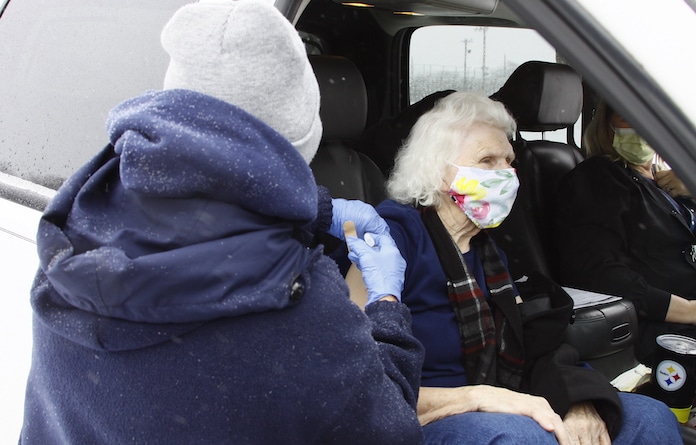Scrutinizing vaccine claims

(This is the second part of an ongoing series focused on examining misconceptions, concerns and myths about the COVID-19 vaccine).
As more people continue to be inoculated against the novel coronavirus, safety concerns for some may diminish when they see so few people having problems.
Still, numerous examples of misinformation or disinformation about the vaccine exist. This article addresses several of those claims.
Misconception: Hundreds of people are dying or having serious side effects from the vaccines.
A prominent example of this misconception is a graph shared widely on social media.
The information is from the Centers for Disease Control and Prevention’s Vaccine Adverse Event Reporting System, so it looks authoritative and troubling.
The simple graph, however, does not capture the nuances of data that make it much less frightening.
When using the VAERS to find this data yourself, the CDC presents a plethora of caveats to the data.
“While very important in monitoring vaccine safety, VAERS reports alone cannot be used to determine if a vaccine caused or contributed to an adverse event or illness,” one such disclaimer reads. “The reports may contain information that is incomplete, inaccurate, coincidental or unverifiable. Most reports to VAERS are voluntary, which means they are subject to biases. This creates specific limitations on how the data can be used scientifically. Data from VAERS reports should always be interpreted with these limitations in mind.”
Other limitations of the VAERS data the CDC lists include that “reports alone cannot be interpreted or used to reach conclusions about the existence, severity, frequency or rates of problems associated with vaccines” and that the percentage shown is the percentage of reports that listed that side effect – not percent of people who got the vaccine and had that side effect.
“Rates of reports may increase in response to media attention and increase public awareness,” the CDC also cautions.
In short, this chart may look scary, but in reality it does not tell much of a story on its own.
Concern: You can die from a severe allergic reaction to the vaccine
It is possible that you could die after a severe allergic reaction to the COVID-19 vaccine, but it is highly unlikely.
A Jan. 15 report from the CDC examined allergic reactions including anaphylaxis, a potentially life-threatening allergic reaction a few people have after getting the first dose of the Pfizer-BioNTech vaccine.
The report found that in over 1.8 million doses administered, there were only 21 cases of anaphylaxis.
That does not mean all those people died, however, because the National Institutes of Health reported in 2017 a mortality risk of less than 1 percent.
Additionally, CDC advises vaccine providers to have supplies on hand to manage anaphylaxis.
A total of 71 percent of anaphylaxis cases occurred within 15 minutes of getting the shot, and the CDC also recommends individuals remain at the vaccination site for that time in case they experience any serious, unexpected side effects.
That is extremely rare. Most people will have only normal side effects after getting a shot like soreness at the injection site or fatigue.
Myth: You should not get the vaccine if you are allergic to eggs.
Speaking of allergies, many vaccines are developed using or containing eggs in some form, rendering them unusable to individuals with an egg allergy.
The COVID-19 vaccine does not have this problem.
“Neither the Pfizer-BioNTech COVID-19 vaccine nor the Moderna COVID-19 vaccines contain egg nor were eggs used in the development or production of either vaccine,” the Mayo Health Clinic reports. “However, those with severe allergic reactions to eggs or any other substance (i.e., anaphylaxis) are encouraged to remain after vaccination for 30 minutes for observation.”
The Food and Drug Administration also provides a full list of ingredients in both vaccines on its website, so individuals can check that to see if they are allergic to any of the components.
Myth: COVID-19 vaccines were developed with fetal tissue.
Again, the Mayo Clinic provides the most concise rebuttal here.
“Neither the Pfizer/BioNTech COVID-19 vaccine nor the Moderna COVID-19 vaccines contain fetal cells nor were fetal cells used in the development or production of either vaccine,” the clinic reported.
Myth: Once you get vaccinated, you do not have to social distance or wear a mask
Unfortunately, this is not the case – at least not yet.
While the vaccines have been shown to protect those who get them from the virus, scientists have not researched whether vaccination prevents spread or even asymptomatic infections.
That means people could be fully protected themselves but still spread the virus to others, making pandemic precautions necessary even after getting inoculated.
In addition, it takes time for the vaccines to be effective.
According to the Cleveland Health Clinic, it takes a week to 10 days for your body to develop antibodies taught by the vaccine.
Plus, both approved vaccines require two shots approximately three or four weeks apart, so individuals are not protected in the interim.
Researchers hope the vaccines will also help prevent the spread of the novel coronavirus, but until studies prove that, public health officials will most likely still recommend precautions.
Myth: If you have already had COVID-19, you do not need to get vaccinated.
While re-infection with this virus is rare, it is possible.
Likewise, experts do not know how long someone has natural immunity after recovering from the coronavirus, especially given the new variants emerging, though early evidence suggests natural immunity may only last a few months at most, per the CDC.
Due to the combination of those factors and the “severe health risks” associated with the virus, the CDC recommends those who have already contracted COVID-19 still get vaccinated when it is their turn.






